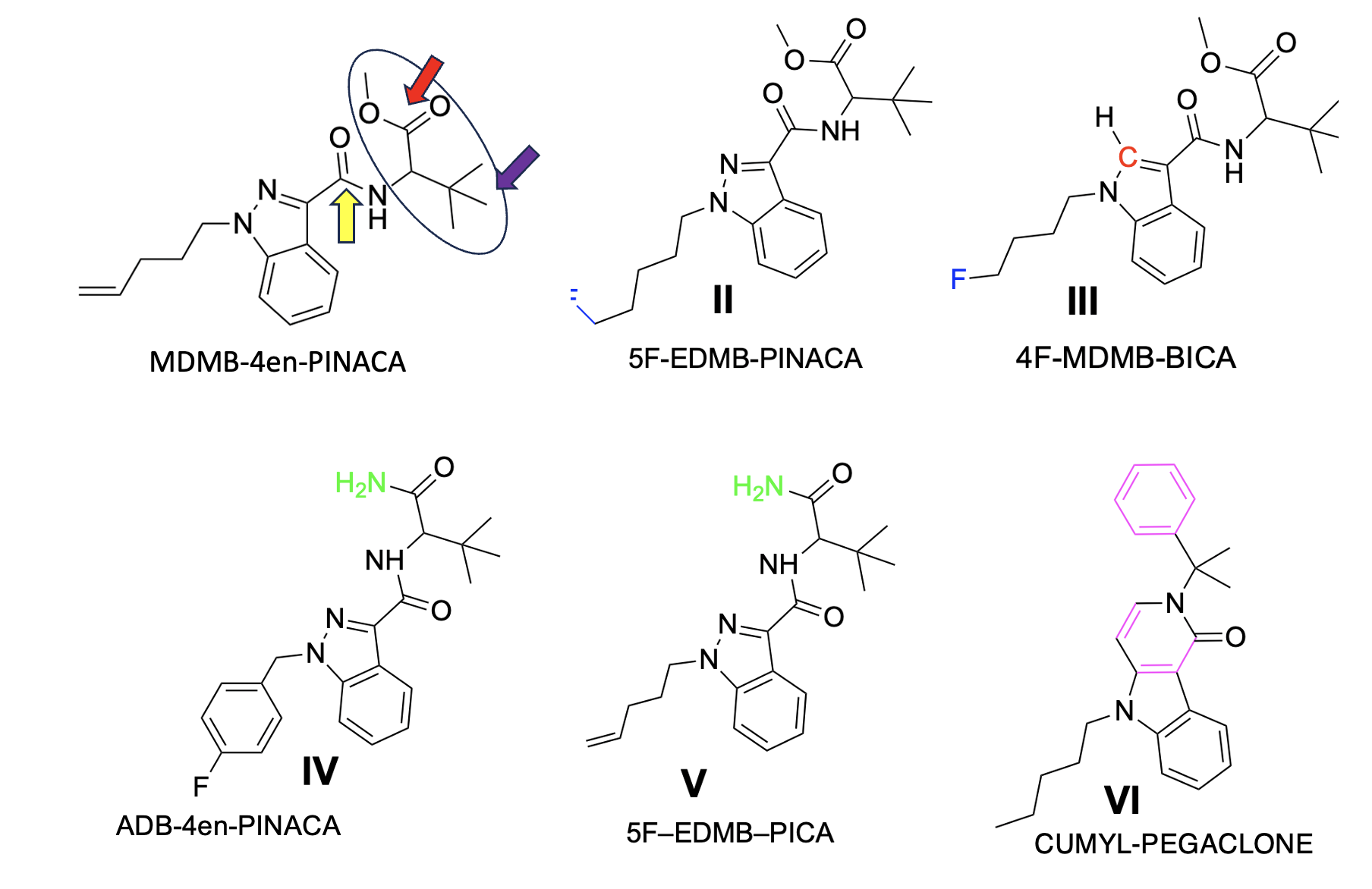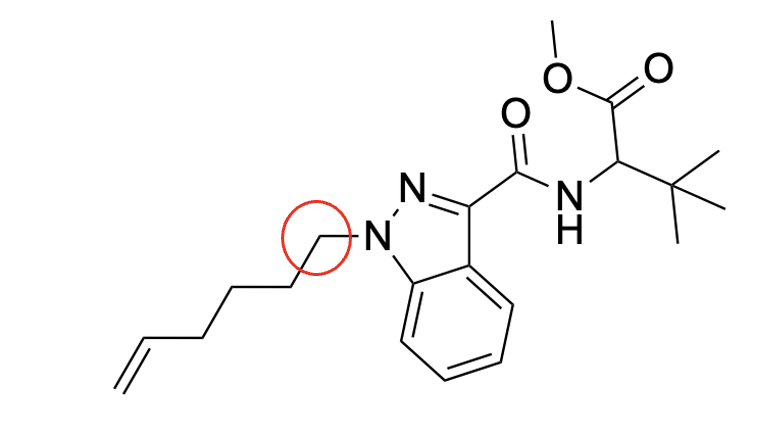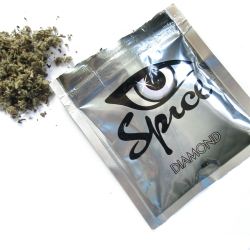The DEA recently added six "new" synthetic cannabinoids to its Schedule I list of illegal drugs (aka Spice, K2, bath salts). Has doing this ever worked in the past? No. Will it work now? Of course not. There are plenty of reasons. Here are some of them. Plus, here's another Dreaded Chemistry Lesson from Hell for all you masochists.
The DEA is chasing its tail, and it's hardly the first time. In 2017, I wrote that new fentanyl analogs were showing up on the street faster than the DEA could identify and schedule them. Whatever the agency was trying to accomplish, which I likened to juggling Jello, seemed futile because Chinese chemists could respond to the scheduling of a newly illegal analog by simply making different compounds that were unknown at that time. Now, we are seeing some of the results. Indeed, this is happening as you read this:
These drugs are not new but are poorly characterized, so it's impossible to know precisely what has been on the street, but the terms "Spice" and "K2" apply to some of them. And they're not really something to fool around with, something I wrote about in 2015 (See About Face! (Chewing): Synthetic Marijuana's Scourge).
Synthetic cannabinoids were described in a 2015 paper in the American Chemical Society Journal of Chemical Neuroscience. [my emphasis]
Synthetic cannabinoid (SC) designer drugs based on indole and indazole scaffolds and featuring l-valinamide or l-tert-leucinamide side chains are encountered with increasing frequency by forensic researchers and law enforcement agencies and are associated with serious adverse health effects. However, many of these novel SCs are unprecedented in the scientific literature at the time of their discovery, and little is known of their pharmacology
Banister, et. al., ACS Chem. Neurosci. 2015, 6, 9, 1546–1559 (2015)
Here is the DEA's latest response
The Administrator of the Drug Enforcement Administration is issuing this temporary order to schedule six synthetic cannabinoids and their optical and geometric isomers, salts, and salts of isomers, whenever the existence of such isomers and salts is possible, in schedule I under the Controlled Substances Act.
Federal Register, 4/13/23
Will this actually accomplish anything? I doubt it. There are more than 250 known analogs of these drugs, forty-three of which have already been listed as Schedule I as of October 2022. Is adding six more to the list going to help? Don't bet on it. Let's look at the six and their structures. It should become obvious how little this solves and how many new synthetic cannabinoids, which are unrelated in structure to THC, could be made in a real hurry by chemists with minimal skills.
Did I hear the word "chemists?" I believe I did! And we all know what that means: Another hideous chapter of The Dreaded Chemistry Lesson From Hell®, whether you want it or not, not being the most likely response.

Steve (left) and his equally cantankerous partner Irving, our hosts of TDCLFH®, return to teach us about non-THC cannabinoids, which they know nothing about. (Not unlike the DEA formulating opioid policies.) Next to them is the chemical structure of THC. Even these two numbskulls can tell that THC has no structural resemblance whatsoever to the six drugs below, even though all seven are cannabinoids by virtue of their binding to cannabinoid receptors.

The six cannabinoids above were recently designated Schedule I by the DEA. Those names must come from some mental facility on Mars. Obviously, it's an insane government-inspired idea. But not completely. See the note below for an explanation if you dare.
Structure and activity
Drugs I, II, and III are similar because they all contain the same amide group (yellow arrow), methyl ester (red arrow), and t-butyl group (purple arrow). I and II are even more similar; the groups attached to nitrogen of the indazole (center) ring differ only by one carbon and a fluorine atom. Without knowing anything about the structure-activity relationship of this class, I will bet that they are more or less the same drug. Drugs II and III are similar but in a different way. III has a carbon atom (red) in the ring in the center, making it an indole rather than an indazole. They also differ by one methylene (CH2) group, which is probably insignificant.
The bottom three are substantially different from the others. IV and V have amide groups (green) in place of the methyl esters – usually, not a trivial change – and IV also has a para-fluorobenzyl group attached to the indazole nitrogen – an entity absent in the other five. Drug VI is both interesting and also problematic. It is significantly different from the others, as indicated in the areas in magenta, yet is still a cannabinoid receptor agonist.
Drug VI is troubling in that it is quite different from the others, suggesting that there is a very large set of similar (and maybe not-so-similar) potential drugs that would be potent cannabinoid agonists, making it essentially impossible to ban (or even keep track of) them. A 2020 paper discussed the types of structural modifications of this broad class and how the chemical structure determines potency.
Where did these things come from?
You've probably heard of them before as "Spice," "K2," "synthetic marijuana," and "bath salts." They are made by chemists in China. Years ago, the drugs began to end up in a variety of places, including convenience stores and gas stations where the bags were labeled "not for consumption," as if this was going to somehow make the stuff legal. And they're very far from harmless:
Acute psychotic episodes, dependence, and withdrawal are associated with use of these synthetic cannabinoids. Some individuals have suffered from intense hallucinations. Other effects include severe agitation, disorganized thoughts, paranoid delusions, and violence after smoking products laced with these substances.
Source: DEA, DOJ
I wrote about "synthetic marijuana" in 2015. See "About Face! (Chewing): Synthetic Marijuana's Scourge." These drugs are probably best known for an incident in which Rudy Eugene, a Florida man, allegedly used a synthetic cannabinoid and later attacked and bit off a large part of a homeless man's face, nearly killing him. Whether Eugene actually used these drugs has also been disputed.
How to stop this?
The 2020 paper by Worob and Wenthur makes it clear that while not every potential drug in this class will be a potent cannabinoid, there is enough latitude in the binding of the drugs to cannabinoid receptors that many will. Although less deadly, the appearance of synthetic cannabinoids on the street is similar to the fentanyl situation, where chemists can skirt the law simply by synthesizing analogs that are not listed, unknown, and probably don't even exist yet, except possibly in the mind of a chemist. This is hardly a new concept. See Organic Chemistry Can Defeat Any Fentanyl Agreement.)
What, if anything, can be done?
The DEA's latest action – to add six more "synthetic marijuana" drugs to a list of 43 – will accomplish nothing. Why? Even if the Schedule 1 classification actually impacts the import, sales, and use of these drugs, countless analogs are already on the street or heading to it. It is very easy to take something like MDMB-4en-PINACA, add one carbon atom (red circle), and there's a new drug that isn't on this latest list.

MDMB-4en-PINACA plus one carbon will be legal and also a cannabinoid agonist. Better? Worse? Who knows. It doesn't really matter because there are undoubtedly thousands of chemicals with similar properties that have either been made or could easily be made.
Something like the HALT Fentanyl Act?
As I've written before, listing a small subset of a potentially unlimited number of similar drugs is chasing your tail. The chemists will always be ahead of the lawmakers. But it is also possible, with the same technique used to write patents, to include a wide range of analog, most of which have never (nor will) be made. It casts a very wide net because it is based on a chemical structure and all the analogs – possibly an infinite number – related to that structure. Here's what a typical generic structure looks like.

An example of a generic structure that could be used in a patent or drug law. The patent defines all the variables – X, Y, Z, R1, etc.. Depending on how these groups are defined, the number of compounds covered by the patent (or law) can be very large, possibly infinite.
Can something like this be used to control synthetic marijuana analogs?
The answer is that it doesn't matter. It will fail to prevent deaths from fentanyl analogs and cannabinoids. Why? My colleague and frequent writing partner, Dr. Jeff Singer of the Cato Institute, explains:
The HALT Fentanyl Act could be dismissed as merely an act of political theater if it wasn't potentially harmful. Placing a generic category of fentanyl analogs on Schedule 1 won't stop the cartels from making and dealing those analogs if it's worth their while. Placing heroin and marijuana on Schedule 1 didn't reduce trade in those drugs. But the harmful part is that by making a whole class of drugs Schedule 1, the government makes research into potentially helpful drugs in that category essentially off-limits. We are just now realizing the potentially helpful benefits of psychedelics, and we have long known of the medicinal uses of cannabis, yet drug development in those areas has been stifled for 50 years because they've been on Schedule 1.
Dr. Jeffrey Singer, private communication, 12/18/23
What will work? Probably nothing. Drug prohibition has failed time after time, and I see no reason why it would start to work in this case. People who want to (or already have) taken illegal drugs will do so no matter what any law says. The best we can do is harm reduction, for example, needle exchange, wide use of methadone, which would probably cut the fentanyl death rate dramatically, and addiction treatment when appropriate. You simply can't solve a complex problem with a simple solution.
NOTE:
(1) These are "code names" based on the chemical name, at least in certain galaxies. Let's look at MDMB-4en-PINACA (Tell me this doesn't get that hideous pina colada song going through your head.) According to the DEA, the chemical name is. Somehow, this gets turned into MDMB-4en-PINACA. How? According to the European Monitoring Centre for Drugs and Drug Addiction:
The MDMB-4en-PINACA code name for the substance is derived from its structural feature): methyl 3,3-dimethylbutanoate linked group (MDMB) [This is OK. Sort of]. Here's why:
- No one on earth would see MDMB and think methyl 3,3-dimethylbutanoate, but at least the letters are in the crazy name].
- 4en stands for a terminal alkene. Why anyone would use this term is beyond me, especially since there are about 40 trillion possible alkenes with terminal (at the end of the chain) double bonds. Much worse is that any multicellular organism will see the "4" and assume that this refers to the number of carbon atoms in the alkene. It doesn't. There are 5 carbon atoms. I'm sure they have their reasons, but I just don't care.
- P "corrects" 4en. It means that the alkene chain has 5 carbon atoms (as in pentane), hence the abbreviation "P." Which I've never seen (except for phosphorous) despite 40 years of being a chemist.
- INA refers to the indazole ring found in four of the six structures above. Again, it contains three letters found in indazole, but I bet I could find 100 organic chemicals that have those three letters in an hour. While playing fantasy basketball.
- PINACA, which sounds like a mouthwash, is more of the same: Methyl 3,3-dimethyl-2-{[1(pent-4-en-1-yl)-1H-indazole-3-carbonyl]amino}butanoate.
I don't know who came up with these abbreviations, but I think a drug test is in order.
(2) HALT is an acronym for "Halt All Lethal Trafficking.”

